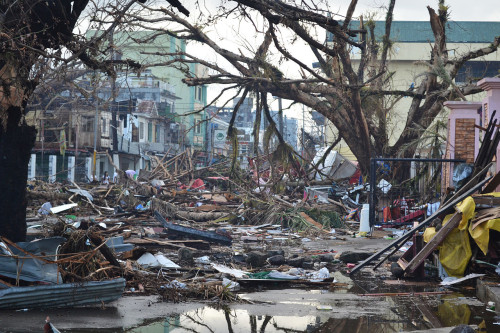 Since super typhoon Haiyan touched down in the Philippines a month ago, millions of Filipinos have been displaced from their homes, including tens of thousands now living temporarily in Manila with no physical homes to return to. The unprecedented damage to infrastructure and serious loss of life has caused some U.S. lawmakers to take up the cause of providing Temporary Protected Status to Filipino nationals living the U.S. who may otherwise be forced to return home.
Since super typhoon Haiyan touched down in the Philippines a month ago, millions of Filipinos have been displaced from their homes, including tens of thousands now living temporarily in Manila with no physical homes to return to. The unprecedented damage to infrastructure and serious loss of life has caused some U.S. lawmakers to take up the cause of providing Temporary Protected Status to Filipino nationals living the U.S. who may otherwise be forced to return home.
Twenty U.S. Senators, Asian American advocacy groups, and other immigration advocates are asking the Department of Homeland Security to consider Temporary Protected Status for the Philippines as a compassionate and practical gesture to aid in relief efforts. Filipino groups are also petitioning President Benigno Aquino III to formally request TPS status for his citizens. Press conferences were held Wednesday to draw attention to their efforts.
What is Temporary Protected Status?
Temporary Protected Status (TPS) is a short-term protected stay for foreign nationals who hail from a country suffering an extreme natural disaster, an armed conflict, or other extraordinary circumstances. The status does not need congressional approval and only applies to foreign nationals already living in the U.S. at the time TPS is offered. TPS does not lead to a green card, though it does provide a temporary work permit and relief from deportation.
TPS cannot be implemented until the affected nation specifically requests it from the United States – in this case, the Philippines has still not yet requested TPS for its citizens living in the U.S. Other countries that currently qualify for TPS are
- El Salvador
- Haiti
- Honduras
- Nicaragua
- Somalia
- Sudan
- Syria
Immigrants who apply for TPS must pass a criminal background check to prove they are not inadmissible for entry to the U.S., and they must meet a few other requirements. The length of time that each applicant’s TPS is valid is subject to the discretion of the U.S. government. Once Temporary Status has been revoked by the government, the individual will revert back to whatever immigration status they had previously.
Why do U.S. Filipinos need Temporary Protected Status?
There are about 4 million Filipino immigrants living in the U.S. today. More than half a million of them –authorized and unauthorized– could benefit from Temporary Protected Status if the U.S. government decides to move forward with it. You might be wondering how this helps Filipino nationals in their own country. There are quite a few benefits to granting TPS in this situation:
- With the number of displaced Filipinos in their own country, it would be a huge burden on relief efforts if undocumented or out of status Filipinos were sent home right now. There is literally not enough infrastructure to support them.
- If U.S. Filipino immigrants have a residence and work permit in the U.S., the can contribute to relief efforts by sending home remittances (already a huge part of the Filipino economy.) If these remittances were to stop, it would have devastating effects for many survivors of the typhoon.
- TPS would also allow out of status Filipinos to leave and re-enter the U.S. as needed so they could visit family or assist in relief efforts if needed. This is most important for undocumented Filipinos, who would be barred from re-entry into the U.S. if they left right now.
Of course, the TPS idea has its detractors, especially those who feel that TPS only encourages unauthorized immigrants to stay in the U.S. even when their status has ended. To be certain, it’s another stopgap measure that doesn’t fully address the bigger problem of 11 million undocumented immigrants living in the U.S. and millions more who are currently documented but can’t find a reasonable way to stay in the U.S. permanently.







